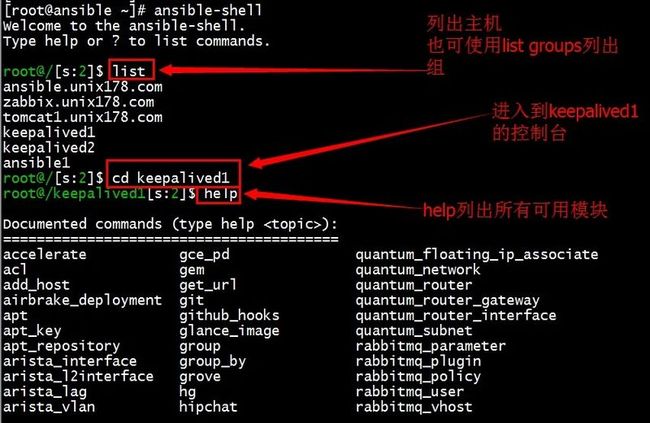自动化运维工具ansible学习+使用ansible批量推送公钥到远程主机
目录:
一、ansible简介
1.1、ansible是什么
1.2、ansible如何工作
1.3、ansible优缺点
1.4、ansible安装方式
1.5、ansible文件简单介绍
1.6、ansible简单使用
二、ansible-shell简介
2.1、ansible-shell是什么
2.2、ansible-shell安装方式
2.3、ansible-shell简单使用
三、使用ansible的authorized_key模块批量推送公钥到远程主机
3.1、生产秘钥对
3.2、使用ansible-playbook来生成推送公钥
四、相关站点的推荐
废话不多说,开始上干货。。。。![]()
ansible是个什么东西呢?官方的title是“Ansible is Simple IT Automation”——简单的自动化IT工具。这个工具的目标有这么几项:让我们自动化部署APP;自动化管理配置项;自动化的持续交付;自动化的(AWS)云服务管理。
下面这是摘自36氪的一段介绍,很详细:
AnsibleWorks成立于2012年,由自动化工具Cobbler及Func的开发者Michael DeHaan创建。其Ansible平台是一个开源的配置及计算机管理平台。可实现多节点的软件部署,执行特定任务并进行配置管理。
Ansible跟其他IT自动化技术的区别在于其关注点并非配置管理、应用部署或IT流程工作流,而是提供一个统一的界面来协调所有的IT自动化功能,因此Ansible的系统更加易用,部署更快。受管理的节点无需安装额外的远程控制软件,由平台通过SSH(Secure SHell)对其进行管理,因此十分方便。其模块支持JSON等标准输出格式,可采用任何编程语言重写。
Ansible可以让用户避免编写脚本或代码来管理应用,同时还能搭建工作流实现IT任务的自动化执行。IT自动化可以降低技术门槛及对传统IT的依赖,从而加快项目的交付速度。
目前,Ansible已有30万用户,每月下载量接近3万次。其客户包括AppDynamics、Evernote 、MapR以及金融服务、电信、医疗保健、媒体业的财富500强公司。
免费版:http://www.ansibleworks.com/docs/
对Ansible底层工作机制感兴趣的可以参考这个: http://www.the5fire.com/explore-the-ansible.html
ansible执行过程大体过程如下图,其中暖色调的代表已经模块化。
图片来源于:http://ju.outofmemory.cn/entry/67581
ansible有如下优点:
1.3.1、轻量级,他不需要去客户端安装agent,更新时,只需要在操作机上进行一次更新即可
1.3.2、批量任务执行可以写成脚本,而且不用分发到远程就可以执行
1.3.3、使用python编写的,维护更简单
1.3.4、支持sudo
缺点:
1.3.5、对于几千台、上万台机器的操作,还不清楚性能、效率情况如何,需要进一步了解。
1.4.1、安装前提Control Machine Requirements
Currently Ansible can be from any machine with Python 2.6 installed (Windows isn’t supported for the control machine).
This includes Red Hat, Debian, CentOS, OS X, any of the BSDs, and so on.
Managed Node Requirements
On the managed nodes, you only need Python 2.4 or later, but if you are are running less than Python 2.5 on the remotes, you will also need:
python-simplejson
1.4.2、源码安装源码地址: https://pypi.python.org/packages/source/a/ansible/ ansible-1.5.5.tar.gz1.4.3、pip安装1.4.4、yum安装
1.5.1、包含文件介绍
1.5.2、ansible其他组件介绍ansible-doc 模块文档查看器,很有用,使用ansible -l 显示所有module列表,使用 ansible-doc <module_x> 来查看module_x的详细文档,这里不做太多介绍
ansible-playbook 传说中的配置管理工具,如果你用过puppet或者saltstack,这个可以不用介绍了,如果你没用过,也没关系,花费20分钟看下官方的Video。 掌握一件事情最好的办法就是使用它,你可以下载官方的example来学习
ansible-galaxy 和三星没关系,你可以把他理解成ansible的pip,可以从galaxy.ansible.com下载官方收录的playbooks
ansible-pull 支持直接从git下载playbook执行,需要遵循其规定的目录格式,用处不是特别大,可以不关注
ansible-vault 如果你的配置文件中含有敏感信息,你可能并不希望他能被人看到,vault可以帮你加密/解密这个配置文件,高级用法,请参照http://blog.ansibleworks.com/2014/02/19/ansible-vault/
1.5.3、ansible的 Inventory 介绍ansible.cfg文件不用去管,我们只需要配置hosts文件即可,hosts文件也就是官方说的Inventory,
hosts文件配置的几种格式:单纯的写主机名或ip,所属组为all
定义一个组
如果你没有使用公钥,想要使用密码,你也可以这样写(适用于第一次登陆控制)格式:【主机名】 【主机地址】 【主机密码】 默认是root用户来进行的
hosts文件设置的参数官方给出的:
1.6、ansible的简单使用
1.6.1、上传公钥到远程主机
定义好了仓库,那么我们就需要把控制端的公钥推送到远程主机上 (稍后会有讲到)
方法:1、使用expect+shell方式批量推送
方法:2、自己手动一个一个的推送
1.6.2、牛刀小试看看效果如何
好了,公钥都传到对方主机了,那么我们来简单的使用来试用下
常用模块:
yum、service、shell、raw
yum模块常用来安装软件
service模块常用来对服务的开关操作
shell模块可以用来执行命令以及脚本
raw和command、shell类似,但是它可以传递管道
NOTE:
通俗点说,ansible执行管理的时候分两部分:
1、Ad-Hoc(我们刚才1.6所演示的就是属于Ad-Hoc)
What’s an ad-hoc command?
An ad-hoc command is something that you might type in to do something really quick, but don’t want to save for later.
详情请查看:http://www.ansible.cn/docs/intro_adhoc.html
2、Playbooks
Playbooks are Ansible’s configuration, deployment, and orchestration language. They can describe a policy you want your remote systems to enforce, or a set of steps in a general IT process.
详情请查看:http://www.ansible.cn/docs/#playbooks
项目地址:https://github.com/dominis/ansible-shell
|
1
2
|
[root@ansible ~]# git clone https://github.com/dominis/ansible-shell.git
[root@ansible ~]# pip install -e ./ansible-shell
|
2.3、ansible-shell简单使用
ansible-shell内置的命令主要有四个:
cd : 切换到指定的组/表达式筛选的机器集合上
list: 显示目前的机器集合,list groups 可以列出所有的组(对我们可能没啥用)
serial: 运行时的并发度,默认是2
help: 顾名思义,他能生成简单的模块帮助信息,方便即时查询
当然,ansible-shell的功能不止这些,这里只是做下简单的演示而已,我们后期会继续更新相关内容
如果你python不错的话,可以在ansible-shell的基础上进行修改,更新,确保更加适合你的环境。
好了,ansible和ansible-shell大致讲解了一下,“知道的越多,肩上的责任越重“,随之而来是你如何在一个很大的环境中来使用ansible,因为ansible是依托于ssh的,难到你要手动的去ssh-copy-id到几十台,几百台甚至上千台机器上么,估计等你公钥都传完了,早已经过了项目上线的时间,在这里我们使用ansible来进行公钥的批量推送,以下几个是我个人思路,如果你有更好的方式请告知
1、shell 脚本 + expect
2、scp 脚本 + expect + 修改authorized_keys文件权限
3、ansible直接推送脚本
个人感觉:
第一个坑:1和2两条的主要问题是,第一次ssh到远程主机上的时候,远程主机会对你进行公钥验证,所以这是一个坑,
第二个坑:针对scp上传之后,文件不对又是另外一个坑
第三个坑:如果只是简单的使用expect的话,remote host主机密码要统一,不统一的话又是一个大坑
第四个坑:使用ansible推送公钥的话,第一次操作需要把远程主机的信息,账户,密码都写到host文件中去,这是一项大的工程
废话不多说,我们继续上干货
三、使用ansible的authorized_keys模块+yaml实现批量上传公钥
这个命令会产生一个公钥(~/.ssh/id_rsa.pub)和密钥(~/.ssh/id_rsa),
-t dsa:表示使用密钥的加密类型,可以为'rsa'和'dsa'
-P '':表示不需要密码登录
-f ~/.ssh/id_dsa:表示密钥存放的路径为${USER}/.ssh/id_dsa
ssh-copy-id -i ~/.ssh/id_rsa.pub username@[ip,hostname] #如果你是单台机器的话,可以使用这种方式把公钥文件传递到对方主机
无图无真相,来看看我们已经做好的一台ansible机器上来罗列远程主机上的authorized_keys的权限,如果你的机器不行,那就改为600即可
3.2、使用ansible-playbook来生成推送ymal文件
authoried_keys模块参数介绍
修改ansible的hosts(Inventory)文件,如下图所示,格式:
[主机名] [ssh连接账户] [ssh主机地址] [ssh连接账户对应的密码]
下面演示我们使用ansible-playbook来推送我们写好的ymal文件
再次查看hosts文件内容
到了这里你可以对着大片的服务器说,管理你们so easy![]() ,从此你不用在为不会except而发愁,解放你的双手,让你更从容,更快速便捷的来管理你的服务器群组!如果你会python,那就是如虎添翼了!
,从此你不用在为不会except而发愁,解放你的双手,让你更从容,更快速便捷的来管理你的服务器群组!如果你会python,那就是如虎添翼了!
四、相关站点的推荐
国内一个团队把1.3的官方文档全部移过来了,从此你再也不用担心阅读官方文档被墙了,感谢他们。。。
对应官方的1.3版本的手册:http://www.ansible.cn/docs/
想要了解yaml的同学可以移步到这里:
YAML的官方网站:http://www.yaml.org
后续主要针对ansible-playbook对线上环境的使用博客,敬请关注
参考文章:
http://www.kankanews.com/ICkengine/archives/136988.shtml
http://www.shencan.net/index.php/2014/04/10/ansible-好***-ansible-shell/
https://github.com/dominis/ansible-shell
https://linuxtoy.org/archives/hands-on-with-ansible.html
https://github.com/ansible/ansible
http://www.the5fire.com/explore-the-ansible.html
http://ju.outofmemory.cn/entry/67581










